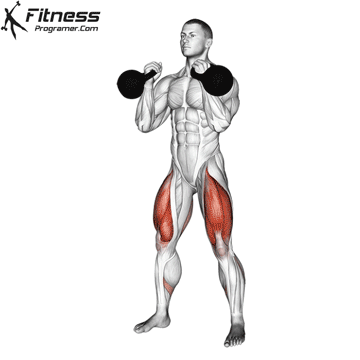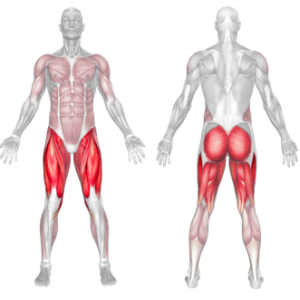Overview
The kettlebell front squat involves holding one or two kettlebells at chest level and performing a squat with proper depth and control. The front rack position activates the core and promotes an upright torso; it works the quads, glutes, hamstrings, and core. This exercise is suitable for all fitness levels and can be used for strength, hypertrophy, or conditioning. It is ideal for functional strength, muscle building, and overall fitness training.
How to do Perform Kettlebell Front Squat

Stand with feet shoulder-width apart, holding a kettlebell in each hand in the front-rack position near your collarbone.
Keep your elbows tucked in and wrists neutral while engaging your core.
Push your hips back and bend your knees to lower into a squat.
Descend until your thighs are at least parallel to the ground, keeping your chest up and back flat.
Drive through your heels to stand back up to the starting position. Repeat for the desired number of reps.
Tips for Proper Form
Keep your elbows high to maintain a strong front-rack position.
Brace your core before descending into the squat.
Ensure knees track over toes and do not cave inward.
Squat to at least parallel, if mobility allows, for full muscle activation.
Drive through your heels, not your toes, on the way up.
Common Mistakes
Letting the kettlebells pull your torso forward, reducing core activation.
Collapsing your chest, especially as you fatigue.
Allowing knees to cave inward during descent.
Using too much weight, leading to poor form and posture breakdown.
Not squatting deep enough, limiting muscle engagement.
Benefits of the Kettlebell Front Squat
Strengthens the Entire Lower Body: Targets quads, glutes, and hamstrings while improving lower-body coordination and power.
Enhances Core Stability: The front-loaded kettlebell position challenges the core to maintain posture and balance.
Improves Posture and Upper Back Strength: Holding kettlebells in front encourages an upright torso and strengthens postural muscles.
Joint-Friendly Alternative to Back Squats: Offers a lower-impact option for those with shoulder or spine limitations.
Builds Functional Strength: Mimics everyday lifting and squatting patterns, improving real-world movement efficiency.
Increases Grip and Arm Strength: Holding kettlebells in the front rack trains the forearms and stabilizing muscles.
Versatile and Accessible: Requires minimal equipment and can be done in small spaces, making it great for home workouts.
How to Incorporate Into Your Routine
- For Beginners: Perform 2 to 3 sets of 8 to 10 reps with light kettlebells to learn the front-rack position and control.
- For Hypertrophy: Do 3 to 4 sets of 10 to 12 reps with moderate weights to target leg growth and core engagement.
- For Strength: Try 4 sets of 4 to 6 reps using heavier kettlebells and longer rest periods.
- For Functional Training: Pair with lunges, carries, or step-ups in a full-body circuit emphasizing real-world movement.
- For Circuit Training: Add to a time-based circuit, performing 30 to 45 seconds of squats between upper-body exercises.
- For General Fitness: Include in your leg or full-body routine with 3 sets of 10 reps using moderate weights.
- For Mobility and Stability: Use light kettlebells and perform slow, controlled reps to improve balance and squat depth.
Muscles Worked

Frequently Asked Questions
Can I use one kettlebell instead of two?
Yes, holding a single kettlebell in the goblet position is a great regression that still trains similar muscles.
Is this exercise good for back pain?
Yes, it offers a spine-friendly option for squatting because of the upright torso position, but always consult your healthcare provider first.
How is this different from a barbell front squat?
The kettlebell version is less stressful on the wrists and shoulders, and it increases the demand on balance and stabilization.
Do I need special kettlebells?
No, any standard kettlebell will work. Just choose a weight that allows proper form without compromising depth or posture.
